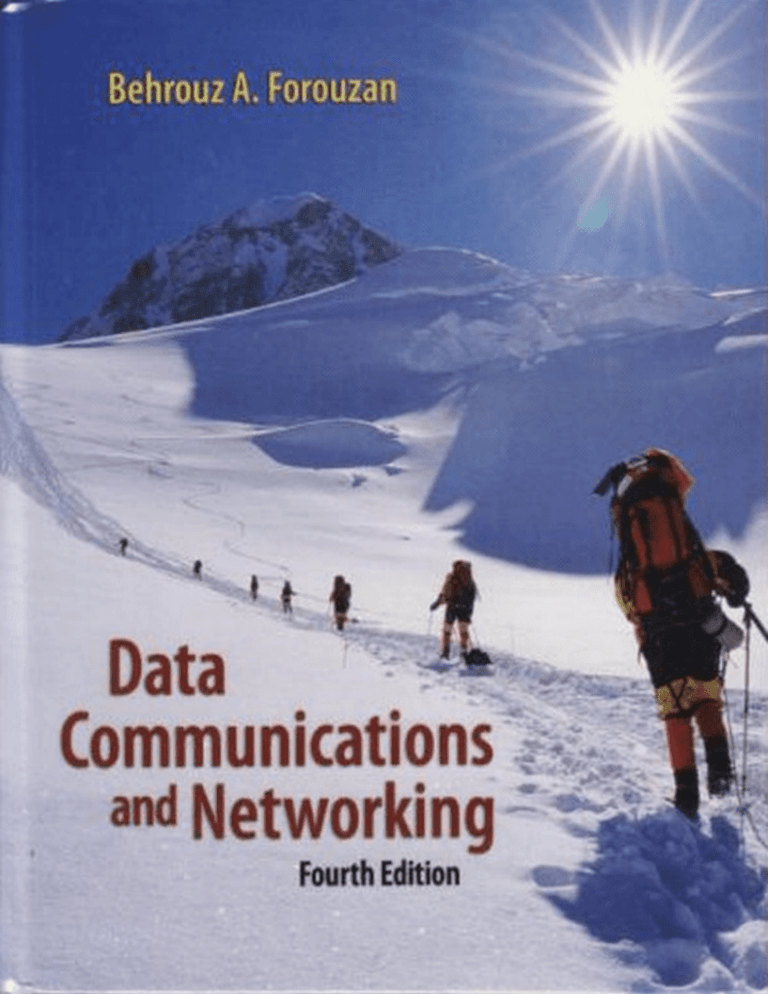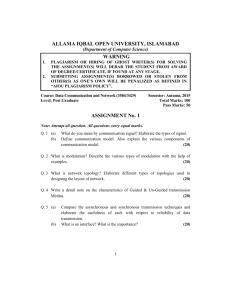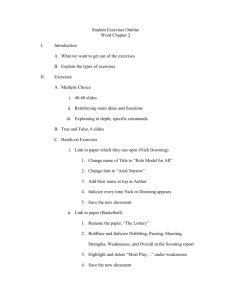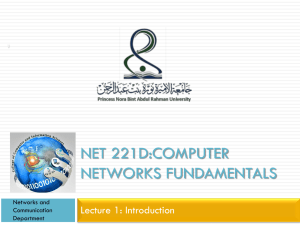
Don't forget to check out the Online Learning Center, www.mhhe.com/forouzan for
additional resources!
Instructors and students using Data Communications and Networking, Fourth Edition
by Behrouz A. Forouzan will find a wide variety of resources available at the Online
Learning Center, www.mhhe.comlforouzan
Instructor Resources
Instructors can access the following resources by contacting their McGraw-Hill Representative for a secure password.
a
PowerPoint Slides. Contain figures, tables, highlighted points, and brief descriptions
of each section.
Complete Solutions Manual. Password-protected solutions to all end-of-chapter
problems are provided.
a Pageout. A free tool that helps you create your own course website.
D Instructor Message Board. Allows you to share ideas with other instructors
using the text.
o
Student Resources
The student resources are available to those students using the book. Once you have
accessed the Online Learning Center, click on "Student Resources," then select a chapter from the drop down menu that appears. Each chapter has a wealth of materials to
help you review communications and networking concepts. Included are:
a
Chapter Summaries. Bulleted summary points provide an essential review of
major ideas and concepts covered in each chapter.
a Student Solutions Manual. Contains answers for odd-numbered problems.
Glossary. Defines key terms presented in the book.
Flashcards. Facilitate learning through practice and review.
a Animated Figures. Visual representations model key networking concepts, bringing
them to life.
D Automated Quizzes. Easy-to-use quizzes strengthen learning and emphasize important ideas from the book.
Web links. Connect students to additional resources available online.
o
o
a
DATA
COMMUNICATIONS
AND
NETWORKING
McGraw-Hill Forouzan Networking Series
Titles by Behrouz A. Forouzan:
Data Communications and Networking
TCPflP Protocol Suite
Local Area Networks
Business Data Communications
DATA
COMMUNICATIONS
AND
NETWORKING
Fourth Edition
Behrouz A. Forouzan
DeAnza College
with
Sophia Chung Fegan
•
Higher Education
Boston Burr Ridge, IL Dubuque, IA Madison, WI New York San Francisco S1. Louis
Bangkok Bogota Caracas Kuala Lumpur Lisbon London Madrid Mexico City
Milan Montreal New Delhi Santiago Seoul Singapore Sydney Taipei Toronto
The McGraw·HiII Companies
.~I
II Higher Education
DATA COMMUNICATIONS AND NETWORKING, FOURTH EDITION
Published by McGraw-Hill, a business unit of The McGraw-Hill Companies. Inc., 1221 Avenue
of the Americas, New York, NY 10020. Copyright © 2007 by The McGraw-Hill Companies, Inc.
AlI rights reserved. No part of this publication may be reproduced or distributed in any form or
by any means, or stored in a database or retrieval system, without the prior written consent of
The McGraw-Hill Companies, Inc., including, but not limited to, in any network or other
electronic storage or transmission, or broadcast for distance learning.
Some ancillaries, including electronic and print components, may not be available to customers
outside the United States.
This book is printed on acid-free paper.
1234567890DOC/DOC09876
ISBN-13
ISBN-to
978-0-07-296775-3
0-07-296775-7
Publisher: Alan R. Apt
Developmental Editor: Rebecca Olson
Executive Marketing Manager: Michael Weitz
Senior Project Manager: Sheila M. Frank
Senior Production Supervisor: Kara Kudronowicz
Senior Media Project Manager: Jodi K. Banowetz
Associate Media Producer: Christina Nelson
Senior Designer: David W Hash
Cover Designer: Rokusek Design
(USE) Cover Image: Women ascending Mount McKinley, Alaska. Mount McKinley (Denali)
12,000 feet, ©Allan Kearney/Getty Images
Compositor: Interactive Composition Corporation
Typeface: 10/12 Times Roman
Printer: R. R. Donnelley Crawfordsville, IN
Library of Congress Cataloging-in~Publication Data
Forouzan, Behrouz A.
Data communications and networking I Behrouz A Forouzan. - 4th ed.
p. em. - (McGraw-HilI Forouzan networking series)
Includes index.
ISBN 978-0-07-296775-3 - ISBN 0-07-296775-7 (hard eopy : alk. paper)
1. Data transmission systems. 2. Computer networks. I. Title. II. Series.
TK5105.F6617
004.6--dc22
www.mhhe.com
2007
2006000013
CIP
To lny wife, Faezeh, with love
Behrouz Forouzan
Preface
XXlX
PART 1
Overview
1
Chapter 1
Introduction
Chapter 2
Network Models
PART 2
Physical Layer and Media
Chapter 3
Data and Signals
Chapter 4
Digital Transmission
101
Chapter 5
Analog Transmission
141
Chapter 6
Bandwidth Utilization: Multiplexing and Spreading
Chapter 7
Transmission Media
Chapter 8
Switching
Chapter 9
Using Telephone and Cable Networksfor Data Transmission
PART 3
Data Link Layer
Chapter 10
Error Detection and Correction
Chapter 11
Data Link Control
Chapter 12
Multiple Access
Chapter 13
Wired LANs: Ethernet
Chapter 14
Wireless LANs
Chapter 15
Connecting LANs, Backbone Networks, and Virtual LANs
445
Chapter 16
Wireless WANs: Cellular Telephone and Satellite Networks
467
Chapter 17
SONETISDH
Chapter 18
Virtual-Circuit Nenvorks: Frame Relay andATM
3
27
55
57
161
191
213
241
265
267
307
363
395
421
491
517
vii
viii
BRIEF CONTENTS
PART 4
Network Layer
Chapter 19
Netvvork Layer: Logical Addressing
Chapter 20
Netvvork Layer: Internet Protocol
Chapter 21
Netl,vork La.ver: Address Mapping, Error Reporting,
and Multicasting 611
Chapter 22
Network Layer: Delivery, Fonvarding, and Routing
PARTS
Transport Layer
Chapter 23
Process-to-Process Delivery: UDp, TCP, and SCTP
Chapter 24
Congestion Control and Quality ql'Sen'ice
PART 6
Application Layer
Chapter 25
Domain Name System
Chapter 26
Remote Logging, Electronic Mail, and File Transfer
Chapter 27
WWW and HTTP
Chapter 28
Network Management: SNMP
Chapter 29
Multimedia
PART 7
Security
Chapter 30
Cf}1J tography
Chapter 31
Network Security
Chapter 32
Securit}' in the Internet: IPSec, SSLlTLS, PCp, VPN,
and Firewalls 995
547
929
931
961
Mathematical Review
Appendix D
8B/6T Code
Appendix E
Telephone History
1059
Appendix F
Co!1tact Addresses
1061
Appendix G
RFCs
Appendix H
UDP and TCP Ports
Index
IIII
1107
873
901
Appendix C
References
761
851
Numbering Systems
1071
703
797
Appendix B
ClOSSOlY
647
795
Unicode
1067
579
701
Appendix A
Acron.Vl11s
549
1029
1037
1043
1055
1063
1065
817
Preface
xxix
PART 1
Overview
Chapter 1
1.1
Introduction
DATA COMMUNICATIONS
Components 4
Data Representation
DataFlow 6
1.2
1
NETWORKS
3
3
5
7
Distributed Processing 7
Network Criteria 7
Physical Structures 8
Network Models 13
Categories of Networks 13
Interconnection of Networks: Internetwork
1.3
THE INTERNET
IS
16
A Brief History 17
The Internet Today 17
1.4
PROTOCOLS AND STANDARDS
Protocols 19
Standards 19
Standards Organizations
Internet Standards 21
1.5
19
20
RECOMMENDED READING
21
Books 21
Sites 22
RFCs 22
1.6
1.7
1.8
KEY TERMS 22
SUMMARY 23
PRACTICE SET 24
Review Questions 24
Exercises 24
Research Activities 25
Chapter 2
2.1
Network Models
LAYERED TASKS
27
27
Sender, Receiver, and Carrier
Hierarchy 29
28
ix
x
CONTENTS
2.2
THE OSI MODEL
29
Layered Architecture 30
Peer-to-Peer Processes 30
Encapsulation 33
2.3
2.4
2.5
LAYERS IN THE OSI MODEL
33
Physical Layer 33
Data Link Layer 34
Network Layer 36
Transport Layer 37
Session Layer 39
Presentation Layer 39
Application Layer 41
Summary of Layers 42
TCP/IP PROTOCOL SUITE 42
Physical and Data Link Layers 43
43
Network Layer
Transport Layer 44
Application Layer 45
ADDRESSING
45
Physical Addresses 46
Logical Addresses 47
Port Addresses 49
Specific Addresses 50
2.6
RECOMMENDED READING
50
Books 51
Sites 51
RFCs 51
2.7
2.8
2.9
KEY lERMS 51
SUMMARY 52
PRACTICE SET 52
Review Questions 52
Exercises 53
Research Activities 54
PART 2
Physical Layer and Media
Chapter 3
3.1
Data and Signals
ANALOG AND DIGITAL
57
Analog and Digital Data 57
Analog and Digital Signals 58
Periodic and Nonperiodic Signals
3.2
3.3
58
PERIODIC ANALOG SIGNALS
Sine Wave 59
Phase 63
Wavelength 64
Time and Frequency Domains
Composite Signals 66
Bandwidth 69
57
59
65
DIGITAL SIGNALS 71
Bit Rate 73
Bit Length 73
Digital Signal as a Composite Analog Signal
Transmission of Digital Signals 74
74
55
CONTENTS
3.4
TRANSMISSION IMPAIRMENT
80
Attenuation 81
Distortion 83
Noise 84
3.5
DATA RATE LIMITS
85
Noiseless Channel: Nyquist Bit Rate 86
Noisy Channel: Shannon Capacity 87
Using Both Limits 88
3.6
PERFORMANCE
89
Bandwidth 89
Throughput 90
Latency (Delay) 90
Bandwidth-Delay Product
Jitter 94
3.7
RECOMMENDED READING
Books
3.8
3.9
3.10
KEYTERMS 94
SUMMARY 95
PRACTICE SET 96
Chapter 4
96
Digital Transmission
4.3
101
DIGITAL-TO-DIGITAL CONVERSION
Line Coding 101
Line Coding Schemes
Block Coding 115
Scrambling 118
4.2
94
94
Review Questions
Exercises 96
4.1
92
101
106
ANALOG-TO-DIGITAL CONVERSION
Pulse Code Modulation (PCM)
Delta Modulation (DM) 129
121
TRANSMISSION MODES
131
120
Parallel Transmission 131
Serial Transmission 132
4.4
RECOMMENDED READING
Books
4.5
4.6
4.7
135
135
KEYTERMS 135
SUMMARY 136
PRACTICE SET 137
Review Questions
Exercises 137
137
Chapter 5 Analog TranSl1'lission
5.1
DIGITAL-TO-ANALOG CONVERSION
Aspects of Digital-to-Analog Conversion
Amplitude Shift Keying 143
Frequency Shift Keying 146
Phase Shift Keying 148
Quadrature Amplitude Modulation 152
5.2
141
ANALOG-TO-ANALOG CONVERSION
Amplitude Modulation 153
Frequency Modulation 154
Phase Modulation 155
141
142
152
xi
xii
CONTENTS
5.3
RECOMMENDED READING
Books
5.4
5.5
5.6
KEY lERMS 157
SUMMARY 157
PRACTICE SET 158
Review Questions
Exercises 158
Chapter 6
6.1
156
156
158
Ba17chridth Utili::.ation: Multiplexing
and Spreading 161
MULTIPLEXING
161
Frequency-Division Multiplexing 162
Wavelength-Division Multiplexing 167
Synchronous Time-Division Multiplexing 169
Statistical Time-Division Multiplexing 179
6.2
SPREAD SPECTRUM
180
Frequency Hopping Spread Spectrum (FHSS)
Direct Sequence Spread Spectrum 184
6.3
RECOMMENDED READING
Books
6.4
6.5
6.6
185
185
KEY lERMS 185
SUMMARY 186
PRACTICE SET 187
Review Questions
Exercises 187
Chapter 7
7.1
181
187
Transmission Media
GUIDED MEDIA
191
192
Twisted-Pair Cable 193
Coaxial Cable 195
Fiber-Optic Cable 198
7.2
UNGUIDED MEDIA: WIRELESS
203
Radio Waves 205
Microwaves 206
Infrared 207
7.3
RECOMMENDED READING
Books
7.4
7.5
7.6
208
KEY lERMS 208
SUMMARY 209
PRACTICE SET 209
Review Questions
Exercises 210
Chapter 8
8.1
208
209
Svvitching
213
CIRCUIT-SWITCHED NETWORKS
214
Three Phases 217
Efficiency 217
Delay 217
Circuit-Switched Technology in Telephone Networks
8.2
DATAGRAM NETWORKS
Routing Table
220
218
218
CONTENTS
Efficiency 220
Delay 221
Datagram Networks in the Internet
8.3
221
VIRTUAL-CIRCUIT NETWORKS
221
Addressing 222
Three Phases 223
Efficiency 226
Delay in Virtual-Circuit Networks 226
Circuit-Switched Technology in WANs 227
8.4
STRUCTURE OF A SWITCH
227
Structure of Circuit Switches 227
Structure of Packet Switches 232
8.5
RECOMMENDED READING
Books
8.6
8.7
8.8
KEY TERMS 235
SUMMARY 236
PRACTICE SET 236
Review Questions
Exercises 237
Chapter 9
9.1
235
235
236
Using Telephone and Cable Networks for Data
Transm,ission 241
1ELEPHONE NETWORK
241
Major Components 241
LATAs 242
Signaling 244
Services Provided by Telephone Networks
9.2
DIAL-UP MODEMS
Modem Standards
9.3
247
248
249
DIGITAL SUBSCRIBER LINE 251
ADSL 252
ADSL Lite 254
HDSL 255
SDSL 255
VDSL 255
Summary 255
9.4
CABLE TV NETWORKS
256
Traditional Cable Networks 256
Hybrid Fiber-Coaxial (HFC) Network
9.5
Bandwidth 257
Sharing 259
CM and CMTS 259
Data Transmission Schemes: DOCSIS
9.6
RECOMMENDED READING
Books
9.7
9.8
9.9
256
CABLE TV FOR DATA TRANSFER
261
KEY TERMS 261
SUMMARY 262
PRACTICE SET 263
Review Questions
Exercises 264
263
260
261
257
xiii
xiv
CONTENTS
PART 3
Data Link Layer
Chapter 10
10.1
265
Error Detection and Correction
INTRODUCTION
267
Types of Errors 267
Redundancy 269
Detection Versus Correction 269
Forward Error Correction Versus Retransmission
Coding 269
Modular Arithmetic 270
10.2
10.3
BLOCK CODING
271
Error Detection 272
Error Correction 273
Hamming Distance 274
Minimum Hamming Distance
274
LINEAR BLOCK CODES
277
Minimum Distance for Linear Block Codes
Some Linear Block Codes 278
10.4
CYCLIC CODES
278
284
Cyclic Redundancy Check 284
Hardware Implementation 287
Polynomials 291
Cyclic Code Analysis 293
Advantages of Cyclic Codes 297
Other Cyclic Codes 297
10.5
CHECKSUM
298
Idea 298
One's Complement 298
Internet Checksum 299
10.6
RECOMMENDED READING
30 I
Books 301
RFCs 301
10.7
10.8
10.9
KEY lERMS 301
SUMMARY 302
PRACTICE SET 303
Review Questions
Exercises 303
Chapter 11
11.1
FRAMING
303
Data Link Control
307
307
Fixed-Size Framing 308
Variable-Size Framing 308
11.2
11.3
11.4
FLOW AND ERROR CONTROL
311
Flow Control 311
Error Control 311
PROTOCOLS 311
NOISELESS CHANNELS
312
Simplest Protocol 312
Stop-and-Wait Protocol 315
11.5
NOISY CHANNELS
318
Stop-and-Wait Automatic Repeat Request 318
Go-Back-N Automatic Repeat Request 324
269
267
CONTENTS
Selective Repeat Automatic Repeat Request
Piggybacking 339
11.6
HDLC
340
Configurations and Transfer Modes
Frames 341
Control Field 343
11.7
332
340
POINT-TO-POINT PROTOCOL
346
Framing 348
Transition Phases 349
Multiplexing 350
Multilink PPP 355
11.8
RECOMMENDED READING
Books
357
357
11.9 KEY TERMS 357
11.10 SUMMARY 358
11.11 PRACTICE SET 359
Review Questions
Exercises 359
Chapter 12
12.1
359
Multiple Access
RANDOMACCESS
363
364
ALOHA 365
Carrier Sense Multiple Access (CSMA) 370
Carrier Sense Multiple Access with Collision Detection (CSMAlCD) 373
Carrier Sense Multiple Access with Collision Avoidance (CSMAlCA) 377
12.2
CONTROLLED ACCESS
379
Reservation 379
Polling 380
Token Passing 381
12.3
CHANNELIZATION
383
Frequency-Division Multiple Access (FDMA) 383
Time-Division Multiple Access (TDMA) 384
Code-Division Multiple Access (CDMA) 385
12.4
RECOMMENDED READING
12.5
12.6
12.7
KEY TERMS 391
SUMMARY 391
PRACTICE SET 392
Books
390
391
Review Questions 392
Exercises 393
Research Activities 394
Chapter 13
13.1
Wired LANs: Ethernet
IEEE STANDARDS
395
Data Link Layer 396
Physical Layer 397
13.2
STANDARD ETHERNET
397
MAC Sublayer 398
Physical Layer 402
13.3
CHANGES IN THE STANDARD
Bridged Ethernet 406
Switched Ethernet 407
Full-Duplex Ethernet 408
406
395
xv
xvi
CONTENTS
13.4
FAST ETHERNET
409
MAC Sublayer 409
Physical Layer 410
13.5
GIGABIT ETHERNET
412
MAC Sublayer 412
Physical Layer 414
Ten-Gigabit Ethernet 416
13.6
RECOMMENDED READING
Books
13.7
13.8
13.9
KEY TERMS 417
SUMMARY 417
PRACTICE SET 418
Review Questions
Exercises 419
Chapter 14
14.1
IEEE 802.11
418
Wireless LANs
421
421
Architecture 421
MAC Sublayer 423
Addressing Mechanism
Physical Layer 432
14.2
417
417
BLUETOOTH
428
434
Architecture 435
Bluetooth Layers 436
Radio Layer 436
Baseband Layer 437
L2CAP 440
Other Upper Layers 441
14.3
RECOMMENDED READING
Books
14.4
14.5
14.6
KEYTERMS 442
SUMMARY 442
PRACTICE SET 443
Review Questions
Exercises 443
Chapter 15
15.1
44 I
442
443
Connecting LANs, Backbone Networks,
and VirtuaL LANs 445
CONNECTING DEVICES
445
Passive Hubs 446
Repeaters 446
Active Hubs 447
Bridges 447
Two-Layer Switches 454
Routers 455
Three-Layer Switches 455
Gateway 455
15.2
BACKBONE NETWORKS
Bus Backbone 456
Star Backbone 457
Connecting Remote LANs
457
456
CONTENTS
15.3
15.4
VIRTUAL LANs 458
Membership 461
Configuration 461
Communication Between Switches
IEEE Standard 462
Advantages 463
462
RECOMMENDED READING
463
Books 463
Site 463
15.5
15.6
15.7
KEY TERMS 463
SUMMARY 464
PRACTICE SET 464
Review Questions
Exercises 465
Chapter 16
16.1
464
Wireless WANs: Cellular Telephone and
Satellite Networks 467
CELLULAR TELEPHONY
Frequency-Reuse Principle
Transmitting 468
Receiving 469
Roaming 469
First Generation 469
Second Generation 470
Third Generation 477
16.2
SATELLITE NETWORKS
Orbits 479
Footprint 480
Three Categories of Satellites
GEO Satellites 481
MEO Satellites 481
LEO Satellites 484
16.3
480
KEY TERMS 487
SUMMARY 487
PRACTICE SET 488
Chapter 17
488
SONETISDH
ARCHITECTURE 491
Signals 491
SONET Devices 492
Connections 493
17.2
487
487
Review Questions
Exercises 488
17.1
478
RECOMMENDED READING
Books
16.4
16.5
16.6
467
467
SONET LAYERS
494
Path Layer 494
Line Layer 495
Section Layer 495
Photonic Layer 495
Device-Layer Relationships
495
491
xvii










